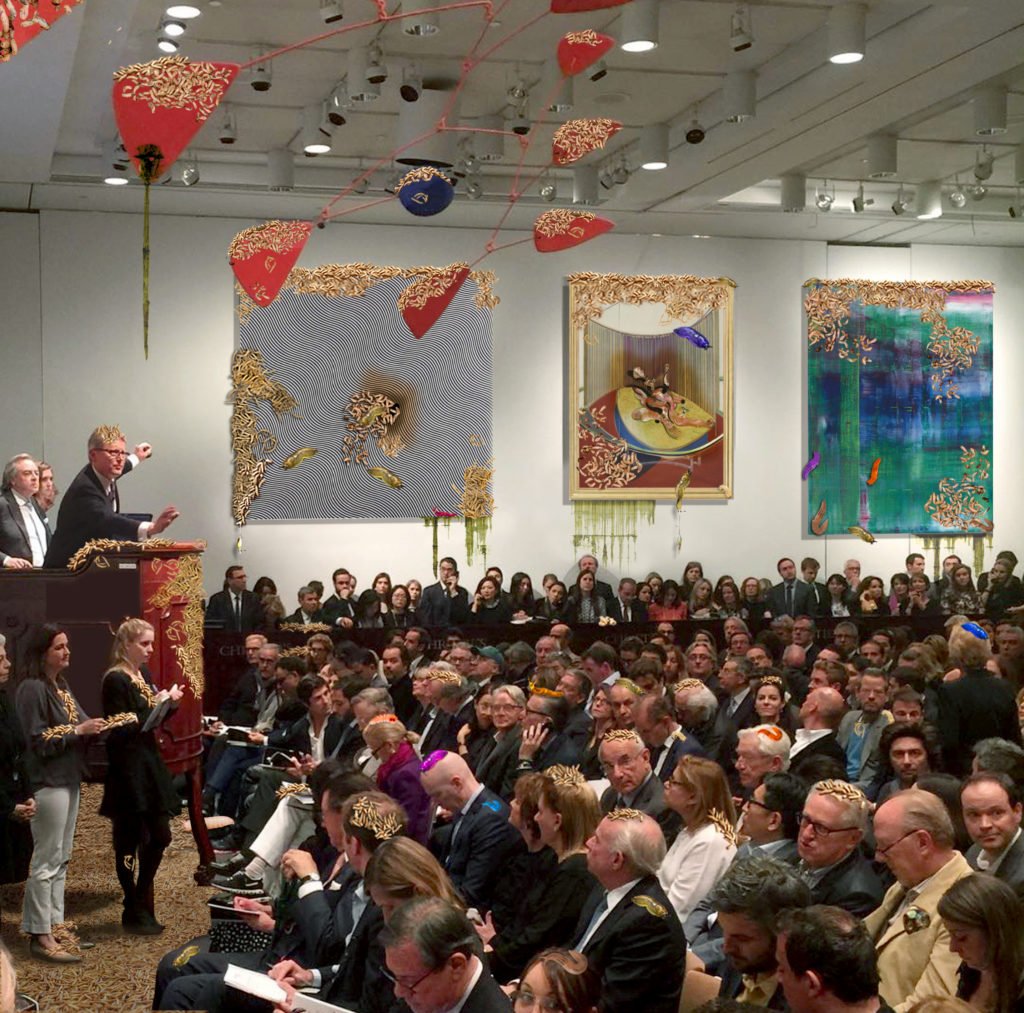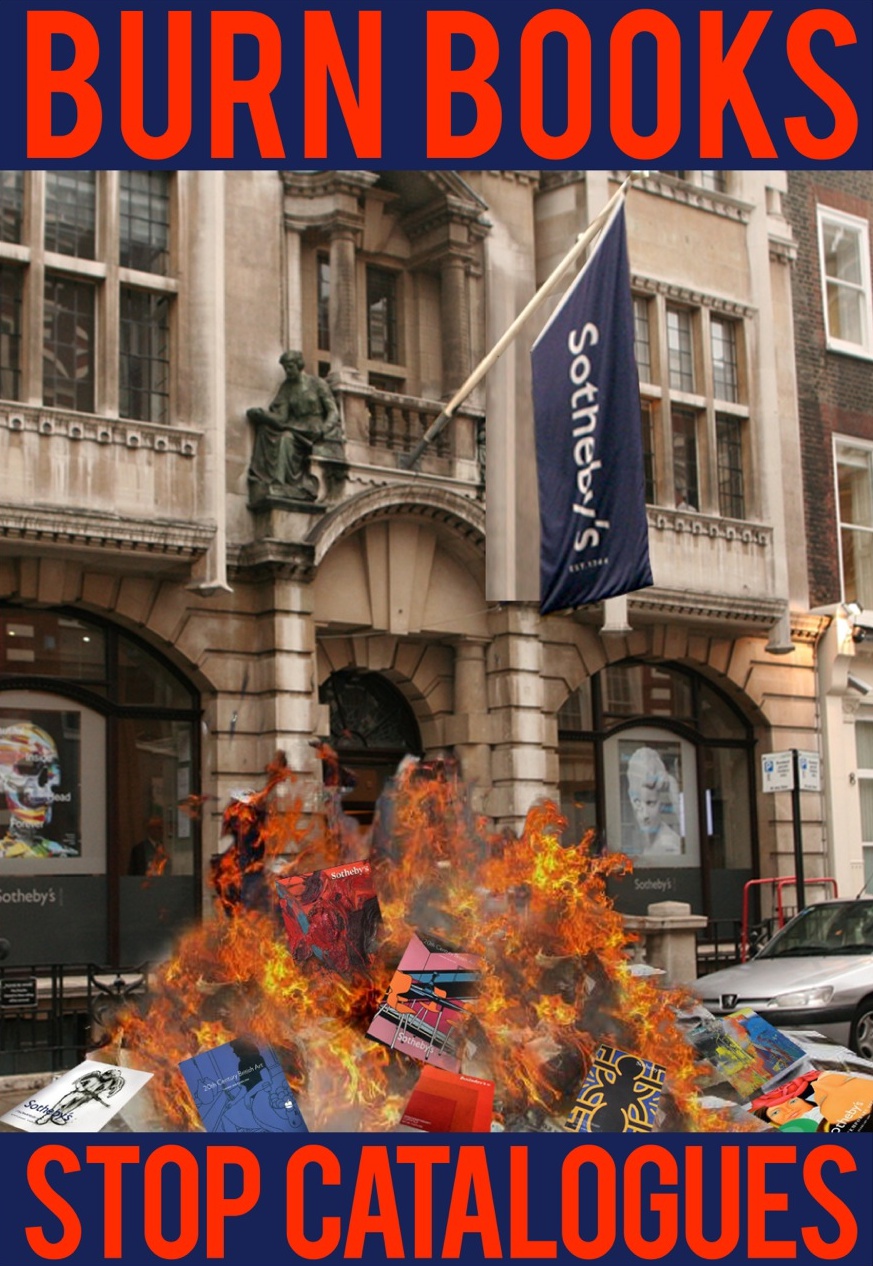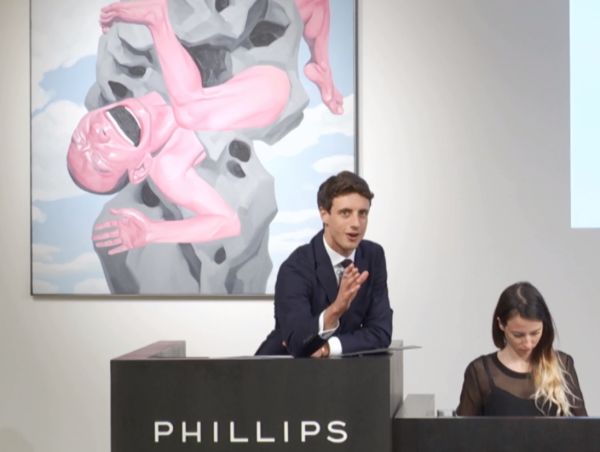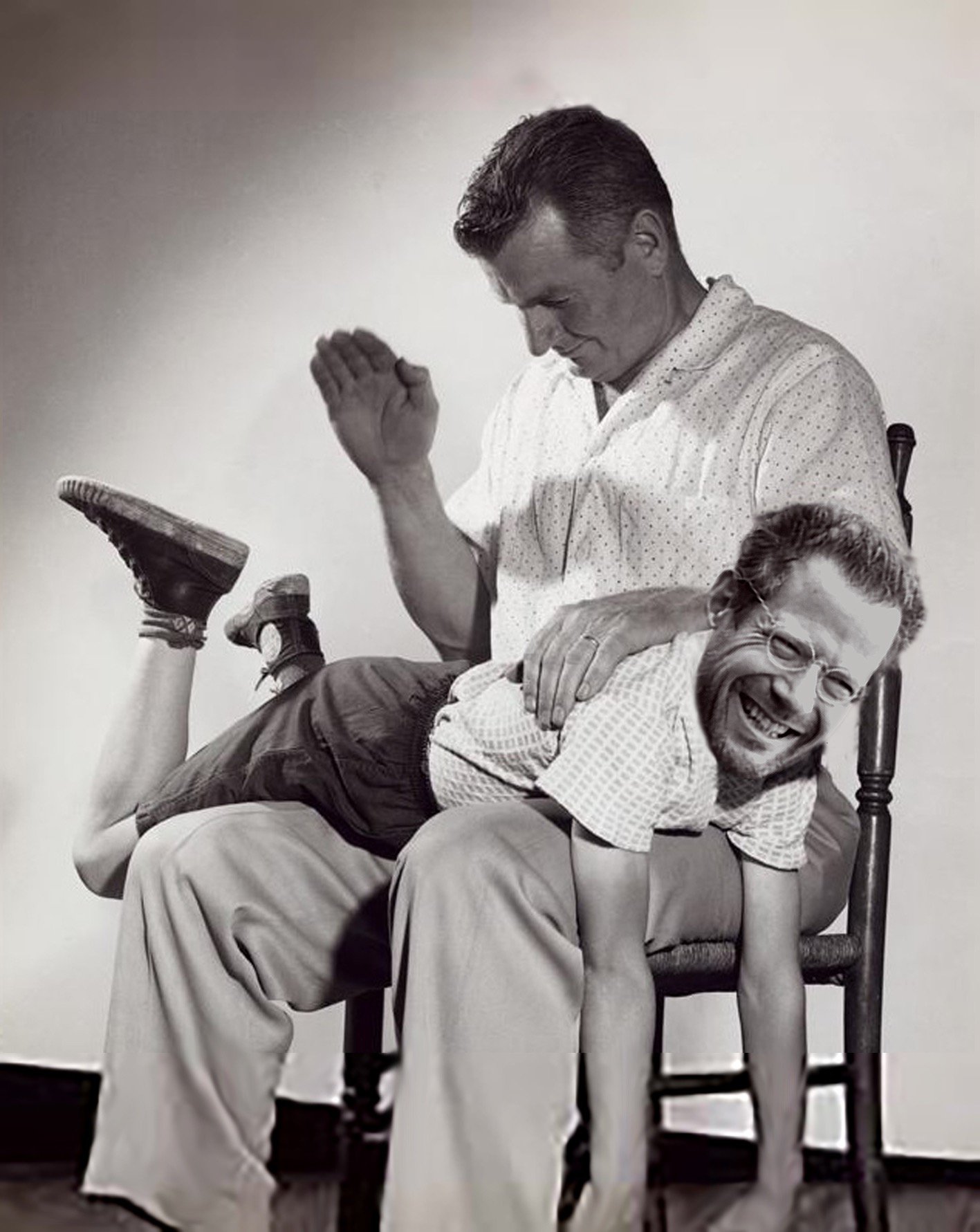Opinion
Kenny Schachter on the London Auctions, Brexit, and the New Nihilists
The art world has never been so topsy-turvy.

The art world has never been so topsy-turvy.

The New Nihilists
Covering the art market today is not unlike being a war reporter working from the trenches—fair and auction aisles—dodging grenades launched by frustrated consultants, dealers and auction personnel (for me anyway). There have been easier periods in which to make a living in art. Perhaps we participants should don designer military fatigues; I guess we already do, by Prada.
As the world frays to the point of coming loose altogether, from the UK’s decoupling from the European Union to the US confronting Trump and what he represents (and elections looming for both) the art world has never been so topsy-turvy. I can’t remember in the past 25 years politics trickling down into the discourse to the extent it has during the June sales of Impressionist, Modern and Contemporary art in London the past two weeks.
As much as Brexit was a backlash against immigration and affluence it was also a blow against the status quo, a move crystallizing into an international phenomenon, call them the new nihilists. They want change and tumult (for it’s own sake?) but don’t seem too sure what form it should take.
I’ve lived in London for 12 years and can sense the disenfranchisement and why many feel excited and nervous by the upheaval, as invigorating as enervating, but hopefully driven by more than retribution and resentment. Brexit was supposed to be a generationally divided issue with the young for remaining but unfortunately the vote coincided with Glastonbury and they must have been stuck in the mud partying.
For a chunk of the press and general public, a big price for a relatively small piece of canvas is a leap few will ever accept. People say globalization failed but I’m delighted by it, still. There will never be a cessation of journalists trying to cast aspersions over the market no matter what the climate.

As Winston Churchill, the esteemed painter and politician, put it: “The best argument against democracy is a five-minute conversation with the average voter” (or journalist, I’d add). For better or worse, the art market is far from democratic but equally resilient; it requires a pile of chips to sit at the table, and the naysayers will never be able to simply talk it down.
By the way, it’s absurd to contend that Brexit figured into collector’s readiness to consign before these sales, I assure you it was on nobody’s radar back then, just another ex post facto negative spin by reporters; smaller sales are a continuation of a recent downward trend in volume (not prices for good works), a reflection of macroeconomic vicissitudes.
More worrisome than any lack of European solidarity is the passage on June 23rd of the draconian German Cultural Property Protection Act giving the government far-reaching rights to prohibit the export of any artworks deemed cultural treasures. It was the same day as the Brexit vote, and all Brexit managed in the end was making a pound lighter.
What’s different is not having to seek approval to sell art works outside the European Union, but for art older than seventy-five years, appraised at €300,000 or more, now requires permission before it could be sold within the EU. Based on suspicion alone, local government officials can barge into your home and conduct a search for booty. Sound familiar?
Like commodity trading pits, auction rooms are windowless halls where the passage of time is marked by overhead bidding screens, a clock that clicks in currencies. Britain, with due respect, is a market minnow, which for a moment when I first relocated in 2004 was considered a contender for international supremacy, a brief glimmer that never materialized.
Past filling old manors with old masters, England never had a very deep collecting culture so nothing too major can or will unfold here. At times auctions resemble a Hogarth composition, a cesspit of moral turpitude, but the upshot of being a less significant arena is a commensurate reduction of sleaze and shenanigans in the salerooms as the overall numbers are relatively too small (as opposed to New York) to attract such dirty deeds.

An unintended consequence of the EU defection was a market imposed currency devaluation adding a fat 10 percent discount due to the drop-off of the pound, feeding Asian and US buying power. Bonhams dealt with the abrupt fluctuation in their concurrent Goodwood Festival of Speed classic car auction by presenting an innovative pricing scheme on their website—estimates in multiple currencies before and after the Brexit vote.
Sitting outside of Scott’s restaurant just prior to the onset of activities, a dealer passed our table and offered to guarantee the Sterling Ruby my lunch mate was offering the following evening with payment proffered in gold bullions. Trading gold for Rubys, there’s an unusual tactic!
What’s to come: art Bitcoins, created by an algorithm calculating the amount of masterpieces per generation back to, say, the renaissance projected forward, selling mathematically derived shares of the action?
Ours is an age fraught with suspicions, fears and flaring tempers as echoed by the dealer that employed a corporate espionage specialist to assure the authentication of a contemporary painting and the advisor I sat next to at a dinner party that launched into a (loud and furious) tirade against me for mere association with a friend that identified her client in the provenance of a work he auctioned. Was his behavior any better or worse than that of the flipping collector?
Before I get underway with the proceedings, I want to call for an immediate cessation of the further publication of auction catalogues—in the screen fed era of near total connectivity, for the art world at least, let devices suffice. Enough. The houses colluded on price fixing, why not do it again for a valiant cause, saving trees; I’m beginning to sound like an eco-warrior worthy of becoming sanctioned to sell to top 100 collector Leonardo DiCaprio.
In trying to devise recycling ideas for the billions of pre-existing volumes in circulation I thought fuel, furniture or weapons of mass destruction that can be blanket bombed into war zones, advancing by the sheer force of blunt impact or scaring combatants into submission with crappy day sale art. When was the last time you paged through one? See? Ok I’m done editorializing.

Atmosphere at Phillips’s London contemporary art auction. Courtesy of Kenny Schachter
Phillips, Sticking to It
I’m having lunch with CEO Ed Dolman who I don’t know but look forward to meeting. From what I understand he was rather encouraged to consider alternative dining plans. I don’t wish anything bad on anyone (well, almost) but Sotheby’s and Christie’s are on another level in terms of the quality of their offerings, theatricality and revved up energy. I admire Amy Cappellazzo, Brett Gorvy and even Phillips if only for their stick-to-itiveness. The talented Cheyenne Westphal should inject something extra when she reports after completing her enforced gardening leave from Sotheby’s (the UK version of a non-compete clause).
Gone are allotted seats vs. Christie’s and Sotheby’s where they are as difficult to come by as securing a coveted table at the (sadly demised) Four Seasons restaurant. At Phillips nobody really wanted to sit up front anyway as repeated rows remained empty. Kemal Cingillioglu and Helly Nahmad were among the only monied players in the room. On an improved note, they changed auctioneers (not soon enough) and on the very first art-trading day of the week, zero lots were withdrawn.
Colin Gleadell, the esteemed warhorse correspondent for the Telegraph as well as this site handed me a dose of classic backhanded Brit humor: “I’ve seen a lot of your writing lately, are you after my job? You must be really failing as an art dealer.” Sounds like something my wife would say. When Phillips’ Russian speaking specialist is engaged on the phone banks, more likely than not it’s the proprietor of the house on the other end keeping things afloat.
I find Anselm Kiefer heavy handed but his abstract painting featuring a toy submarine affixed to the surface motored out of the showroom at £2,389,000 on an estimate of £400,000-£600,000, a pound record though third in dollar value.
Yue Minjun, whose market has been sleepy since soaring to a high of nearly $7 million in 2008, fetched a shocking £965,000 for an Untitled painting from 2006, estimated at £100,000-£150,000: Phillips rocks! Not even my Chinese friends could get their arms around that one.
Phillips has been feeling the effects of one thing or another since it’s inception but fared well meeting the medium of presale expectations. Chrysler was always the third party out after Ford and General Motors before being subsumed after multiple attempts to resuscitate the company; which begs the question, what is Phillips’s business model?

Sotheby’s, Only as Good as Your Last Sale
Having to systematically stage auctions is a hapless job like putting out a magazine, you are only as good as your last sale and it starts anew the day after. And extricating art is no easy task, not to mention having to sell so much of it. I counted at least 65 people manning the phones at Sotheby’s; I guess not exactly everyone has fled the company. The evening was a resounding success, above the high estimate and I’m thrilled for them, wow. But they could do without the loud music video before the sale that resembled a sports match promo.
Former Sotheby’s contemporary executive Lisa Reuben, a close friend, bagged a red Rudolf Stingel resembling the impression of an oriental carpet, bidding over the phone. With fees the well bought painting made £1,745,000 on an estimate of £1.5-£2 million but the hammer price was below the low estimate. Deep Pockets informed me the consignor turned down two higher third party guarantee offers moments before the sale, a loss down to the vagaries of art gaming, a verified gambling category in itself.
When one of the multitude of sloppy abstract/figurative hybrids by market darling (for now) Adrian Ghenie up for offer during the week (10 in all) appeared on the block the independent curator seated next to me chortled, “Adrian Ghenie looks like he belongs in The Affordable Art Fair,” and refused to mark her catalogue with the selling price as is customary (civil disobedience). Another pal told me Pace had to shut down our friend LDC (DiCaprio) the waiting list is so long and formidable. Ha.
Catching up to her male peers, and rightfully so, a Jenny Saville oversized canvas made £6,813,000 (stuff that, Mr. Baselitz), estimated at £1.5-£2 million and went to the Long museum in China, just off the purchase of an endless Richter stripe painting in Basel. Is there something to the Long museum only collecting long art?
Christie’s, More a Scalping Than a Haircut
One minute you hear confidence reinstalled in the market until the next sale that generates less than the total of a single decent 1960s Ferrari. Christie’s Impressionist and Modern sale was more a scalping than a haircut for what was a day sale gussied up, masquerading as a night event. It didn’t work.
A positive was that the Chinese appear to be beginning to buy a wider array of Western contemporary art and I can only see this continuing to grow. It’s very generous of artnet News to translate my articles into Chinese, receiving criticism by an entirely fresh and expanded audience is something I truly appreciate. But it goes to show you where the market for contemporary is headed…everywhere.
A saccharine green and violet Gerhard Richter squeegee painting, Abstraktes Bild (1994) erred on being too tasteful in relation to the artists sought after works with jarring, contrasting colors. This was the second two-meter Richter withdrawn in London within six months for what could only be construed as lack of interest. Sometimes a wall consuming Richter is enough of a wealth signifier to warrant mega bucks, but not in the last two cases. Most significantly why this work was pulled might have had something to do with the fact I was offered it by no less than four galleries in the last year alone.
Johnny Depp, prominently featured in posters around Christie’s, sold his Basquiat collection for a whopping profit—when you buy his art you get a singed headshot signaling thanks for contributing to his legal defense fund for his impending hotly contested divorce. One British collector found a novel way to convert his or her pounds into dollars of another sort by buying Warhol’s “Two Dollar Bills (Fronts) [40 Two Dollar Bills in Red]” from 1962 that hammered under estimate but still equaled a robust £4,450,500 (estimated at £4-£6 million).
Lastly, a 250th Anniversary Show, another cockamamie themed sale, testing collective collecting limits: art by largely dead Brits. Let me add that loan exhibits don’t belong intermingled in auctions, sorry. Three centuries of great British art is as problematic and pompous as the sentiment that drives divisions. Besides a Freudian scaled drama where a featured Lucien Freud bought-in, they made considerably more selling Henry Moore, £24,722,500, Bridget Riley, £4,338,500, John Constable, £14,082,500 and Francis Bacon at £27,242,500, among others, where many records were made and the highest tally of the week was achieved, so what the Hay?
What’s to Come
The only certainty in life is uncertainty, as Luther Vandross sang it, always and forever. I’m exhausted and I’m sure you are too (especially if you’ve been reading this column), a good time to take it in and digest what will unfold next. In the face of unprecedented madness art performed faultlessly in London’s June sales. Even Phillips.
Brexit was a wakeup call that represents a lack of societal cooperation and scaremongering in a world occasionally riven apart by the shortsightedness of prejudice and politics. I say Brexit schmexit; the art alliance is a bond stronger than any union, uniting all in its path.
During catastrophic flooding of the Arno River in Florence in 1964, the worst since the sixteenth century, more than a hundred died and thousands of artworks destroyed but also as many saved by a brigade of volunteers that came to be known as the mud angels. The unbridled passion for the preservation of art brought people together for a common enterprise and nothing has changed in that regard.
Aside from the complete breakdown of leadership across the British political spectrum, the roiled world financial markets are fast returning to pre-Brexit levels. The next barometer, the November sales in New York, will gain on the results of May; who am I to argue against the momentum? You can slow the flow (of art and the market) but nothing can or will ever stop it—the production or consumption.
At the expense of sounding as sanctimonious as a Kiefer painting looks, I am left with pride and empathy, nothing but compassion for those responsible for indisputably hard fought battles during some of the most volatile times in recent memory, and relief! But I’m not surprised.